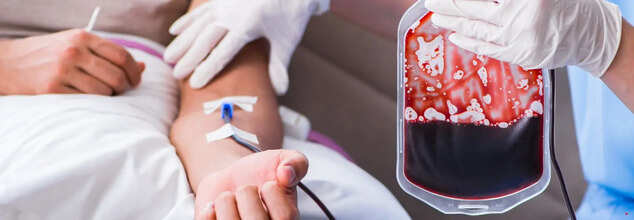- Health Conditions A-Z
- Health & Wellness
- Nutrition
- Fitness
- Health News
- Ayurveda
- Videos
- Medicine A-Z
- Parenting
- Web Stories

Credit: Canva
This Super Common Condition Causes Up To A Third Of All Dementia Cases
Eating nutritious food to engaging in new age fitness routines, people across the world are doing everything to stave off Dementia. Now, new research suggests that treating a super common condition early on could delay the onset of this condition for years. Scientists from Johns Hopkins University in Maryland who tracked seniors with hearing loss discovered that roughly a third of all dementia cases could be attributed to the impairment. Publishing their findings in the journal JAMA Otolaryngology, the research team noted, “This suggests that treating hearing loss may delay dementia for a large number of older adults."
Here's How The Research Was Conducted
Researchers analysed 2,946 adults aged 65 and older over eight years and found 32% of all dementia cases could be attributed to diagnosed hearing loss. For those with mild hearing loss, of developing dementia was 16.2%. Among those with moderate to severe hearing loss, the risk increased to 16.6%. The risk was slightly higher for women than for men, at 30.8% and 24%, respectively. Notably, a higher number of cases attributed to hearing loss occurred in people aged 75 and above.
Experts are uncertain whether hearing loss directly causes dementia or whether it creates other conditions that raise the risk. The team is hopeful their findings will inspire changes in the way hearing loss is detected and treated. "Public health interventions targeting clinically tested hearing loss might have broad benefits for dementia prevention," they said. This latest research comes on the heels of a landmark 2024 study from The Lancet that found nearly half of all Alzheimer’s cases could be delayed or prevented by addressing 14 risk factors.
Dementia affects more than 6 million Americans and accounts for more than 100,000 deaths each year. In addition to hearing loss, risk factors of dementia include lower levels of education, high blood pressure, tobacco use, obesity, depression, diabetes, excess alcohol intake, traumatic brain injury, air pollution, social isolation, vision loss, high cholesterol and a sedentary lifestyle.
Study Suggests Hearing Aid For People
The Lancet study also included 13 recommendations to help reduce the risk of dementia. The list included an initiative to make hearing aids accessible for people who need them and decrease harmful noise exposure to reduce hearing loss. According to current statistics, only about 20% of US adults who would benefit from a hearing aid use one. That may be because hearing loss tends to be an invisible disease.

Credits: Instagram & Wikimedia Commons
Bryan Johnson Says Botox And Shockwaves Improved His Nighttime Erections By 34%
In mid-2023, the tech mogul and self-proclaimed biohacker, the anti-age crusader Bryan Johnson began a new chapter in his longevity journey. He is already known his extreme anti-aging regimen - Project Blueprint. He has turned his attention to something unconventional. However, it is a telling health metric: nighttime erections.
He has now started a daily dose of 2.5mg of tadalafil (Cialis). He has set out to track and enhance what he calls a crucial "vital sign". His goal is not performance, but optimization. He tells his followers on X, the results were "titanic".
By early 2024, Johnson had added focused shockwave therapy and Botox injections to the mix. Within three months, he says, his nighttime erections improved by 34%. It has clocked in at quite an impressive three hours, with biological equivalent of an 18-year-old.
It Is Not Just About Sex
While the idea of three-hour erections may sound like a punchline, Johnson is pretty serious about it. "Nighttime erections," he explains, "are a strong biomarker of cardiovascular, psychological, and sexual health." These spontaneous erections during sleep can reflect a man’s overall physical and vascular health.
What is interesting to see is that he also maintains that Cialis itself is unlikely to be the sole driver of his sexual function improvements. While the drug is FDA-approved to treat erectile dysfunction, Johnson says it mainly supports long-term health. His claims are that it helps with improved heart function, cognitive health, and reduced urinary symptoms in men.
The Therapy Protocol
In order to push his results further, Johnson also turned to shockwave therapy. This is a treatment that involves acoustic pulses delivered via a wand to the penis.
The shocks cause micro-injuries that stimulate blood flow and tissue repair - not unlike how muscles grow after a workout. However, it is not a spa day. Johnson rated that the pain is 7 on a scale of 10. When it is "at the tip", the pain goes up to 9 on a scale of 10.
Alongside the shockwaves, Johnson began Botox injections, which might sound bizarre but are backed by emerging science. Botox, typically used to reduce facial wrinkles, is thought to relax the smooth muscle in blood vessel walls, allowing more blood flow and potentially firmer erections.
ALSO READ: The Longevity Diet: Bryan Johnson Eats 3 Meals In 6 Hours—With Extra Virgin Olive Oil
What Are The Results Like?
After three months on this combined protocol, Johnson says his nighttime erections rose from 2 hours and 15 minutes to 3 hours. Despite the gains, he reportedly sleeps alone, keeps an 8:30 p.m. bedtime, and schedules sex, if at all.
His larger aim? To maintain all his organs — brain, liver, teeth, even his rectum — at peak teenage condition through strict diet, 111 daily supplements, and intensive routines.
While Johnson’s methods are extreme, he hopes they help reduce stigma. “Men, if you’re not performing how you’d like, there are many paths to improvement,” he said. “There’s no shame in this — in fact, it will make you more of a man to address it head-on.”

Why Its Important To Check The Expiry Date On Your Pregnancy Test?
If you're trying to conceive or even think you might be pregnant, the wait and anticipation for a pregnancy test can be nerve-wracking—hope, worry, excitement, or fear all in one little plastic stick but before you rip open that foil package, there's something important you may be forgetting: the expiration date.
Yes, pregnancy kits do have expiry dates. And taking one which has passed that date may cause false results. This article touches on why checking that date on the kit first is important before you test, how pregnancy kits work, and what dangers such expired kits possess. Supported by expert opinion and scientific knowledge, this guide endeavors to equip you with the knowledge you require for making informed reproductive health choices.
Home pregnancy tests detect the human chorionic gonadotropin (hCG) hormone in your urine, which your body begins making shortly after the fertilized egg implants in your uterus. The test sticks use special antibodies with chemicals that have been treated to respond to hCG and report a positive finding—usually lines, plus symbols, or messages on a display.
With time, though, the delicate components break down. After the test has reached or exceeded its expiration date, the chemical reagents can no longer act dependably. That is, the test might not register hCG when it's actually there, providing you with a false negative result, or—much less often—report a false positive based on poor chemical reactions.
What Happens When a Pregnancy Test Expires?
The date of expiration on a pregnancy test is not merely a courtesy. Companies test their products extensively to find out how long the ingredients will be stable and consistent under normal storage conditions. A pregnancy test will usually be effective for one to three years from the date of manufacture.
Once that time has passed, the antibodies that are employed to identify hCG start to weaken. This weakening is subtle but significant—making the test incapable of giving accurate results. The older the test, the greater the likelihood that you'll leave with a result that doesn't accurately represent your pregnancy status.
Just as important as the expiration date is how the test is stored. According to healthcare professionals, the performance of a pregnancy test can deteriorate even before its listed expiry if it’s stored improperly.
Avoid exposing the test to heat, moisture, or direct sunlight. A bathroom medicine cabinet, while convenient, is often not ideal due to the humidity from showers and temperature fluctuations. Instead, keep pregnancy tests in a cool, dry place, and avoid unwrapping individual tests until you’re ready to use them. Unsealing the protective foil can introduce air and moisture that degrade the chemicals faster.
How to Identify an Expired Test?
Always inspect the outer package and test wrapper individually for a printed expiration date. If it is absent or smudged, better not take a risk. Also, beware of buying tests from third-party retailers or online stores where expired stock may go unnoticed.
It's also good to know that even tests just purchased can be old inventory. If you've had a test kit in your bathroom drawer for more than one year, verify the printed date before you use it.
Can You Trust an Expired Test?
Technically, it's possible for an outdated pregnancy test to return a correct result—but it's not reliable. The odds of false negatives grow more sharply with time, which can cause confusion, worry, and delay in obtaining critical prenatal care.
Under FDA recommendations, most erroneous results from past-due tests are likely to be false negatives. This may lead one to continue habits or drugs that are not best practiced in early pregnancy—or lose the opportunity to start early prenatal supplements or tests.
The effect of depending on an out-of-date pregnancy test isn't only medical—it's psychological as well. Inaccurate results can induce undue distress, confusion, or early rejoicing. Even worse, they may stall time-critical health choices like verifying the pregnancy through a physician, making blood work appointments, or starting lifestyle modifications to facilitate a healthy pregnancy.
In medical situations where time is of the essence—like watching over high-risk pregnancies or starting specific treatments—true, timely information is paramount.
Best Practices for Taking a Home Pregnancy Test
To ensure most accurate results, follow these steps:
- Inspect the expiration date before taking any test, even if the package appears new.
- Take first-morning urine when hCG is most concentrated in the urine.
- Wait until the first day of your missed period to take the test; testing earlier riskily produces a false negative.
- Take directions exactly, including timing when to read the results.
- Dispose of unused tests properly, in a dry, cool environment and in their original sealed package.
How Expired Pregnancy Tests Impact Health and Results?
Taking an expired pregnancy test can result in incorrect results, which might lead to undue confusion or undue delay in taking the appropriate next step. Here's what you should know regarding the effectiveness of an expired pregnancy test:
Increased Chance of False Negatives
One of the most significant problems with using an outdated pregnancy test is the increased likelihood of getting a false negative result. This is where the test will show that you're not pregnant when you actually are. This is due to the chemical compounds, especially the antibodies employed to identify hCG, breaking down over time, thus it becomes hard for the test to give a true result.
Degraded Antibodies
Pregnancy tests detect human Chorionic Gonadotropin (hCG), a hormone that is formed during pregnancy. After a while, the antibodies in the test, which cause a response when hCG is present, become weakened. So even if you are pregnant, the test may fail to measure the hormone at a level that is high enough.
Health Risks
As per the U.S. Food and Drug Administration (FDA), expired pregnancy tests tend to give false negatives rather than false positives. A false positive may also occur but is less so with expired tests.
Exposure to External Factors
The reliability of a pregnancy test is also affected by the way it's stored. Incorrect storage, for example exposure to sunlight, humidity, or heat, causes the components to degrade faster and results in more opportunities for getting incorrect results prior to reaching expiration.
Waste of Time and Money
Using an expired test not only reduces the likelihood of getting an accurate result but also wastes your time and money. It's best to check the expiration date before using the test and, if expired, purchase a new one for peace of mind and more reliable results.
Emotional Stress
The effect of depending on an out-of-date pregnancy test isn't only medical—it's psychological as well. Inaccurate results can induce undue distress, confusion, or early rejoicing.
Though home pregnancy tests are an efficient and convenient means of early pregnancy detection, their accuracy relies on a number of major factors, foremost among them their expiration date. Testing with one that has expired may cause emotional distress and delay medical attention at a time when it's needed most.

Credit: Canva
Can You Get Malaria Without Mosquito Bite?
Malaria is a life-threatening disease that is spread to humans by a specific type of mosquito. It is preventable and curable, but only if detected on time. People who are at high risk include travellers, pregnant women and those with HIV/AIDS. On Friday, while marking World Malaria Day, the World Health Organisation (WHO) asserted that half of the total global population is at risk of this vector borne disease. So now, the question arises: how does it spread?
Malaria is a vector-borne disease. It is spread through female anopheles mosquitoes. These mosquitoes carry single-cell P. Falciparum, which is a pathogen behind this disease. There are five types of Plasmodium parasite, with P. Falciparum (which is found in the African region) and P. Vivax ( common outside the sub-Saharan region) being the most popular. Left untreated, P. Falciparum malaria can progress to severe illness and death within 24 hours.
Malaria Can Be Spread Through Blood Transfusion
But there is empirical evidence that it can also be transmitted through blood transfusion and contaminated needles. Transfusion-transmitted malaria (TTM) occurs when an uninfected person receives blood from a donor who is infected with malaria parasites. While malaria transmission through transfusion is rare, especially in non-endemic areas, it remains a significant concern in certain regions.
According to a systematic review of studies conducted by National Library of Medicine, Plasmodium parasites were shown to survive in whole blood and plasma when stored at 4°C for up to 18 days, and detectable parasites can present even up to 28 days when frozen, although with diminished infectivity.
How To Identify Malaria?
The early symptoms of Malaria are fever, headache and chills, which can usually start within 10 to 15 days of getting bitten by an infected mosquito. Some types of malaria can cause severe illness and death. Infants, children under 5 years, pregnant women, travellers and people with HIV or AIDS are at higher risk. Severe symptoms include:- extreme tiredness and fatigue
- impaired consciousness
- multiple convulsions
- difficulty breathing
- dark or bloody urine
- jaundice (yellowing of the eyes and skin)
- abnormal bleeding
Disproportionate Share Of Global Malaria Burden
The WHO African Region continues to carry a disproportionately high share of the global malaria burden. In 2023, the region was home to about 94% of all malaria cases and 95% of deaths. Children under 5 years of age accounted for about 76% of all malaria deaths in this region. Over half of these deaths occurred in four countries: Nigeria (30.9%), the Democratic Republic of the Congo (11.3%), Niger (5.9%) and United Republic of Tanzania (4.3%).
© 2024 Bennett, Coleman & Company Limited

